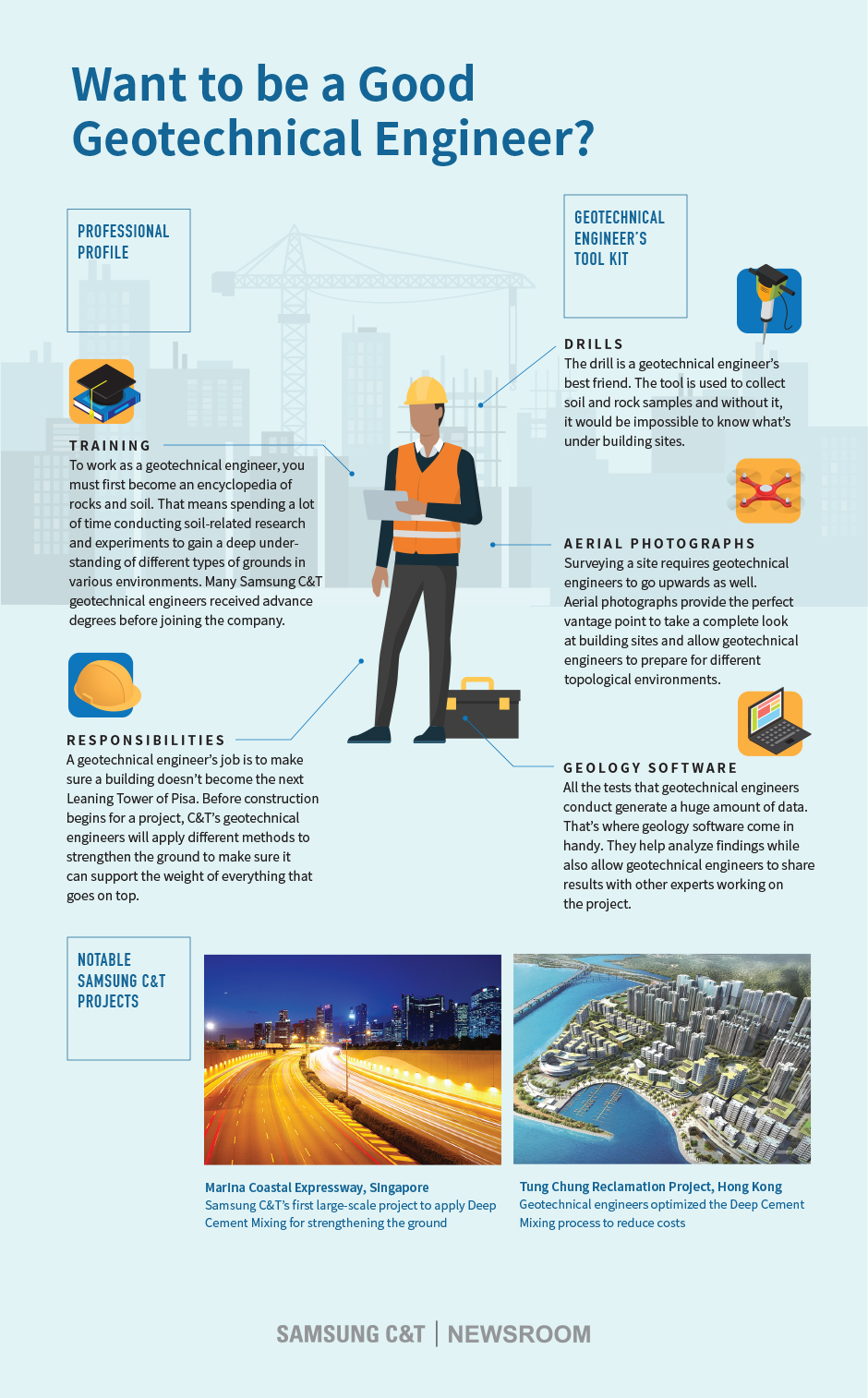The 10-Second Trick For Geotheta
Table of ContentsGet This Report on GeothetaGet This Report about GeothetaThe Best Guide To GeothetaThe Greatest Guide To GeothetaGeotheta for Dummies

They perform website examinations, collect examples, do lab tests, and analyze information to review the suitability of the ground for building and construction jobs - Engineer of Record. Based on their findings, geotechnical engineers give recommendations for structure style, incline security, preserving structures, and reduction of geotechnical dangers. They work together with other experts, such as designers, structural designers, and building and construction groups, to ensure that geotechnical considerations are incorporated right into the overall project design and application
By evaluating the behavior and residential or commercial properties of dirt and rock, they can recognize possible geotechnical risks such as landslides, soil negotiation, or incline instability. Their knowledge assists stop failings or crashes that might jeopardize lives and residential property. Below are some detailed responsibilities and duties of a geotechnical engineer: Site Investigation: Geotechnical designers conduct website examinations to gather information on subsurface conditions.
They interpret the information to understand the homes and habits of the dirt and rock, including their toughness, leaks in the structure, compaction characteristics, and groundwater conditions. Geotechnical Evaluation and Style: Geotechnical engineers evaluate the data gathered throughout site investigations to examine the security and suitability of the website for construction tasks. They do geotechnical computations and modeling to evaluate elements such as birthing ability, negotiation, slope security, side earth stress, and groundwater circulation.
Excitement About Geotheta
Structure Style: Geotechnical engineers play a vital function in developing structures that can safely sustain the intended structure. They examine the dirt problems and load demands to figure out the proper structure type, such as shallow structures (e.g., grounds), deep foundations (e.g (https://geotheta.blog.ss-blog.jp/2024-08-02?1722614750)., piles), or specialized techniques like dirt improvement. They consider factors such as settlement limits, bearing capacity, and soil-structure communication to establish ideal structure styles
They assess building plans, monitor site tasks, and conduct field examinations to validate that the style recommendations are followed. If unforeseen geotechnical problems occur, they analyze the circumstance and supply referrals for remediation or modifications to the style. Risk Assessment and Mitigation: Geotechnical engineers evaluate geotechnical hazards and dangers connected with the job website, such as landslides, liquefaction, or soil disintegration.

Collaboration and Interaction: Geotechnical designers work very closely with various other specialists entailed in a job, such as architects, architectural engineers, and construction groups. Reliable interaction and collaboration are necessary to integrate geotechnical factors to consider right into the overall job style and construction process. Geotechnical engineers offer technological knowledge, answer inquiries, and guarantee that geotechnical needs are satisfied.
Geotheta for Beginners
Here are some kinds of geotechnical engineers: Structure Designer: Foundation engineers focus on developing and assessing structures for frameworks. They assess the dirt conditions, tons needs, and site characteristics to establish one of the most appropriate foundation kind and design, such as superficial structures, deep structures, or specialized methods like heap foundations.
They examine the factors affecting slope stability, such as soil properties, groundwater conditions, and slope geometry, and establish strategies to prevent slope failures and mitigate dangers. Earthquake Engineer: Quake designers concentrate on assessing and developing frameworks to hold up against seismic pressures. They analyze the seismic risk of a site, assess dirt liquefaction capacity, and develop seismic design criteria to make certain the safety and security and durability of frameworks throughout earthquakes.
They execute area testing, gather samples, and assess the gathered data to characterize the soil residential or commercial properties, geologic developments, and groundwater conditions at a website. Geotechnical Instrumentation Designer: Geotechnical instrumentation designers concentrate on surveillance and determining the actions of dirt, rock, and frameworks. They mount and preserve instrumentation systems that keep track of aspects such as soil settlement, groundwater degrees, slope motions, and architectural variations to evaluate efficiency and provide very early warnings of possible problems.
Not known Incorrect Statements About Geotheta
They perform examinations such as triaxial examinations, consolidation examinations, direct shear tests, and leaks in the structure examinations to collect information for geotechnical analysis and design. Geosynthetics Designer: Geosynthetics designers concentrate on the design and application of geosynthetic products, such as geotextiles, geogrids, and geomembranes. They utilize these materials to improve dirt stability, enhance slopes, give water drainage remedies, and control disintegration.
They tend to be investigatory people, which means they're intellectual, reflective, and inquisitive. They wonder, systematic, logical, analytical, and rational. Several of them are also social, meaning they're kind, generous, participating, person, caring, practical, understanding, skillful, and friendly. Does this sound like you? Take our free profession test to learn if geotechnical engineer is just one of your top career suits.
In the workplace environment, geotechnical designers make use of specialized software program tools to perform computations, create designs, and examine data. They prepare reports, testimonial project requirements, communicate with customers and group members, and coordinate job tasks. The workplace setting supplies a helpful setting for research, analysis, and partnership with various other specialists entailed in the project.
An Unbiased View of Geotheta
They often go to job sites to perform site examinations, analyze geotechnical go to the website conditions, and gather information for analysis. These gos to entail traveling to various places, in some cases in remote or difficult surfaces. Geotechnical designers may perform soil sampling, conduct tests, and display building activities to ensure that the geotechnical facets of the task are being implemented properly.
Geotechnical engineers additionally work in specialized geotechnical research laboratories. In these centers, they conduct experiments, execute examinations on dirt and rock examples, and assess the design residential properties of the materials. Geotechnical research laboratory engineers function thoroughly in these settings, dealing with testing tools, running instruments, and recording data. They work together with various other research laboratory personnel to make sure exact and trustworthy screening outcomes.